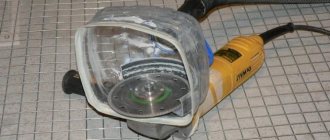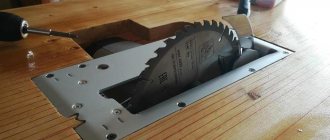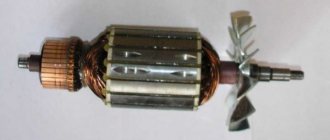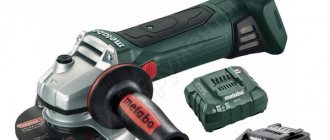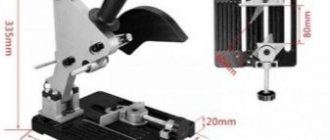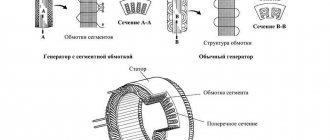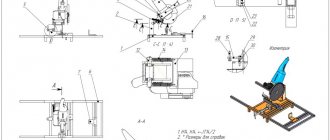The grinder is a simple but extremely popular hand-held power tool that has managed to gain noticeable popularity in most types of technical and repair work. Its capabilities cannot be called too broad, as is the range of functional abilities, but the tasks themselves that the grinder solves are inaccessible to other tools.
Users appreciate angle grinders and are constantly trying to refine and improve the set of functions and capabilities. Let's consider one of these options that can make using the tool clean and comfortable.
Self-production
Making a casing for an angle grinder for a vacuum cleaner with your own hands is not difficult. You just need to approach the problem with imagination. There are many materials for manufacturing:
- aluminum pan or plate;
- plastic oil canister;
- plastic bottle with a volume of 5 liters.
Standard casing
A less expensive manufacturing method is to use a standard protective device. You only need to attach the side cover and pipe to it. To make a side cover, you can take a piece of galvanized steel and then proceed like this:
- Cut strips of galvanized steel 15 mm wide and 30 mm long to make corners. Then bend them at a right angle in the middle.
- In the side open part of the casing, drill holes with a diameter less than the thickness of the screws. Fasten the previously made corners through these holes.
- Cut out the side cover from galvanized steel along the contour.
- Drill a hole in it closer to the edge for the pipe.
- The pipe can be made by rolling a sheet blank into a pipe. The edges can be secured together with self-tapping screws or clamps.
- One edge of the pipe must be cut in several places. And straighten these sectors.
- Insert the pipe into the cut-out cover and secure with self-tapping screws.
- Also use self-tapping screws to screw the resulting structure to the corners.
- Attach the structure to the grinder.
- Connection to the vacuum cleaner is made via a corrugated hose. To ensure a secure connection, you must use a clamp.
That's it, the angle grinder with a vacuum cleaner casing is ready for work.
Plastic canister model
After changing the oil or pouring antifreeze into the car, plastic cans always remain in the garage. Thick walls and ebbs in the corners allow it to retain its shape well without deforming. In addition, the size of the canister neck almost matches the size of the vacuum cleaner hose.
Before cutting, you should decide on such a parameter as the immersion depth of the cutting disc. An installed dust extractor will prevent immersion. You can use a standard casing as a basis.
- First, mark with a marker.
- Use a sharp construction knife to cut holes and cut off unnecessary parts. It is recommended to make holes for mounting on the grinder on both sides. This is necessary in case there is a need to change the direction of rotation.
- The hose is connected to the neck using a clamp.
- The dust extractor is secured to the angle grinder using a clamp with an adapter ring.
- To close an unused mounting hole, you need to cut a circle of a larger diameter and secure it with self-tapping screws.
Tile cutter attachment
Cutting ceramic tiles requires constant supervision. And the exhaust hood for the angle grinder completely blocks the view. To make the casing you need a transparent material.
A 5-liter transparent bottle of bottled water is suitable as a blank. The neck includes the vacuum cleaner pipe. Using a utility knife, cut a hole for the planting.
The bottom of the bottle is cut so that the disc is set to the required height. The structure is secured to the angle grinder with a clamp or screws. The large volume of the bottle does not allow dust to fly away, and the casing simultaneously serves as a dust collector.
Grinder cutting machine
In order to understand how to make a cutting machine from an angle grinder (angle grinder), you can look at various drawings on the Internet. But they will be of little help, since all the dimensions of the parts will still have to be selected based on the size of the grinder you have. Options for making devices can be either simple or more complex, requiring the ability to operate a welding machine.
Option 1
To make this device for an angle grinder, you will need welding skills. So, you need to do the following.
First, cut 2 small pieces from the corner (50x50 mm). Their size is selected based on the dimensions of the gearbox of your angle grinder.
Next, drill holes with a diameter of 14 mm in them and screw the corners to the angle grinder, as shown in the following photo. If you do not have suitable bolts, you can use M14 threaded studs. Just be careful that the bolts are not too long. Otherwise, in some models of angle grinders they may cling to the impeller located in the gearbox housing.
Without removing the corners from the angle grinder, secure them by welding. After this, the corners can be removed and scalded well.
Sand the weld seams using a grinder attachment.
Then you need to make a rotating support for the lever on which the device will be mounted. To do this, select 2 pipes of such diameters that one can fit into the other without much effort.
For a more precise cut, you can glue masking tape to the tubes and draw a line on it.
Then, turning the tube, carefully cut it with an angle grinder. A piece of pipe with a smaller diameter should be 20 mm shorter (the thickness of 2 bearings) - it will serve as a spacer.
For a thicker pipe, select 2 bearings suitable for its inner diameter. After this, insert the thin tube into the thick one and press the bearings on both sides.
Then insert the pin into the bearings. Be sure to place a washer in front of the nut.
When the rotating mechanism is ready, you need to weld a small piece of corner to it.
At the next stage, a stand for the rotating mechanism is made from the same 50x50 mm corner. To ensure that the pieces are the same length, the corners can be tightened with a clamp and trimmed.
Also, without unscrewing the clamp, they can be drilled immediately.
Attach the angles with drilled holes to the ready-made rotary block using nuts.
Weld a longer corner to this rack, as shown in the following photos.
Now you need to decide on the length of the lever on which the angle grinder will be attached. This is done by selection based on the dimensions of your angle grinder. You can lay out the parts on the table and calculate the approximate dimensions of the lever, which is best made from 2 pieces of square profile pipe 20x20 mm.
The pipes also need to be clamped with a clamp and cut to the same size.
Once all the parts are ready, they can be welded together, as shown in the following photos.
At the next stage, you can attach the angle grinder to the finished structure and check again what came out of it.
The finished pendulum mechanism for an angle grinder can be easily installed on any flat surface, for example, on a workbench. This structure can also be installed on a table specially made for it. For a more rigid fastening of the mechanism, you can weld small sections of the corners on both sides of the long corner and drill holes in them.
In the following photos you can see how a ready-made attachment for an angle grinder is mounted on a table (in this case a metal frame is used).
It is very important to set a right angle between the plane of the cutting disc and the plane of the table. Place the square on the table and move it towards the abrasive wheel mounted on the angle grinder. If you initially managed to weld the fixture so that the angle between the planes was 90 degrees, then that’s good. If you notice a deviation from a right angle in one direction or another, then you can correct the situation using a crowbar or a long profile pipe, for example, 60x20 mm.
To prevent the part from moving when cutting, you can screw a corner onto the table that will serve as a stop. Also, for precise cutting, the table can be easily improved with a simple vice, made from a nut welded to it and a pin of the required length screwed into it.
Next, you need to make a protective casing. It is done taking into account the maximum diameter of the cutting disc, which can be installed on a specific model of angle grinder. To make it easier to determine the size of the casing and the places for its attachment, you can first make a template, for example, from a piece of cardboard.
- You need to cut 2 blanks from tin for the future casing.
- Screw an aluminum corner to one of the blanks. With its help, the casing will be attached to the rod of the device.
- Twist the 2 halves together.
- On the rod of the pendulum mechanism, drill holes for the angle attached to the casing, cut threads in them and screw on the protective casing.
In this case, the casing will also serve as a limiter for the cutting tool, preventing it from going too deep into the table while processing the part.
It would not be amiss if the lever with the grinder attached to it was spring-loaded. In this case, this is easy to do: insert a smaller tube from the back of the rod and attach a spring to it, as shown in the following photo.
At this point, the manufacture of a cutting machine with your own hands, in which an angle grinder is used as a drive, can be considered complete.
Option 2
The next version of the device for the grinder, with which you can cut metal workpieces, is done as follows.
- Take 2 sections of profile pipe of the same height and weld them to a rectangle pre-cut from sheet metal.
- Drill holes in 2 posts and in the lever (the length is selected experimentally), then secure the latter with a bolt, as shown in the photo below.
- Attach a spring to the back of the lever.
- Drill a through hole at the intended location for attaching the angle grinder to the rod.
- Now you can secure the grinder to the table.
Thus, we got a simple cutting machine. To add additional rigidity to attaching the device to the lever, you can use clamps by first placing, for example, a wooden block between the angle grinder body and the pipe.
For precise cutting, so that the workpiece does not move, you will need to screw a corner to the table.
A similar version of the device is also suitable for a small angle grinder, only the angle grinder will be attached to a metal strip: on one side with a bolt to the angle grinder itself, and on the other with a clamp.
For a powerful angle grinder, the device is made according to the same principle, but from larger profiles than in the figures above.
It is not necessary to use dumbbells as a counterweight. All you have to do is find a suitable spring.
Option 3
This version of the device is the easiest to make with your own hands. It is made without a traditional stand (stand) for the rotating block. All you need is one door hanger, a metal strip, and an elastic band (you can use a rubber band from a hand-held resistance band).
The design is done as follows:
- in the metal strip, on one side, drill holes for the door canopy, and on the other, for a bolt, which will be used to fasten the strip to the angle grinder;
- screw the angle grinder and canopy to the strip;
- screw the canopy to the table;
- fasten one end of the elastic band to the edge of the table, and the other to the holder (handle) of the angle grinder.
In just a few minutes you will get a high-quality cutting machine. This device is also mobile, because it can be carried with you in a suitcase with tools, and, if necessary, mounted on any flat surface.
When installing this device, do not forget to attach a corner to the table to rest the workpiece against it.
Purpose of the dust collector for angle grinders
Homemade vacuum cleaner: example
Using an angle grinder (grinder) to carry out repair work on concrete at home creates a large amount of dust.
If you need to level a wall, sand it for painting or applying other types of finishing coating, all irregularities or bumps become tiny particles of concrete suspended in the air.
Despite the personal protection used, they penetrate the mouth, eyes, and respiratory organs.
In addition, dust settles on all pieces of furniture, walls, ceilings and other surfaces, requiring labor-intensive and time-consuming cleaning. Dust from brick walls eats into surfaces and irreversibly spoils their appearance.
There are several designs of casings with a pipe for connecting a vacuum cleaner, which significantly improve the process. They are purchased in a store and installed on an angle grinder, connected to a vacuum cleaner. Working with such devices almost completely eliminates the spread of dust and can significantly reduce the pollution of the room and indoor air. Outwardly, they resemble conventional protection, but with a closed housing and an outlet for connecting a vacuum cleaner hose.
Types of casings
Housing for a grinding attachment
There are quite a few types of accessories for an angle grinder that perform dust collection and removal tasks.
Manufacturers are aware of the problem and solve it by producing special devices for their equipment.
Based on the type of functionality, two options are available:
- for cutting discs;
- for grinding discs.
The first ones outwardly resemble conventional protection with a closed housing and a pipe for a vacuum cleaner. The second option is a closed lid with an outlet for connecting a vacuum cleaner hose. Both types are installed in the usual way on an angle grinder and do not require special tools for installation. Most users are familiar with the common models:
- Stomper SG-230;
- Stomper SG-230 R;
- BOSCH 1605510180;
- BOSCH 2605510107;
- BOSCH 2605510224;
- BOSCH 2602025285;
- Metabo GED125;
- Metabo GED125 Plus.
Important! It is impossible to provide an exhaustive list of protective covers for angle grinders, since the model range is constantly being supplemented, new developments are appearing, and the most promising models are being improved.
Making a fixture
With dust extraction from the pan
When it is possible to find an old aluminum pan, you can make a dust collector without using a welding machine. The main part of the casing is cut out and fits well to an angle grinder. When performing this work, it is necessary to accurately calculate in advance the maximum penetration depth of the cutting disc, because the height of the cross cut from below directly depends on this.
A seat for mounting on an angle grinder is cut out of another part of the aluminum pan. The hole diameter must be measured directly on the power tool. The size of the dust extractor must be as accurate as possible so that the casing cannot come off due to strong vibration when performing work.
In a similar way, you need to make a pipe for a vacuum cleaner. The protruding edges of the casing should be folded inwards as carefully as possible along a single line to secure the side wall, which can be made from any type of material. For example, a wall can be easily made from thin metal sheet. If there is a desire, then it is worth giving the device a more aesthetic appearance, treating the joints and painting them with enamel.
From a plastic canister
Next, we will consider another economical option for dust removal. In any person’s pantry you can find empty plastic containers for various technical liquids. This container holds its shape well and is quite easy to process. And also such a container has a convenient outlet pipe of the required size.
First, fitting is done, the main purpose of which is to ensure the required immersion depth of the cutting disc. Using a construction knife, cut out the required through holes. Their diameters are chosen in such a way that the homemade structure retains its rigidity. It is worth making special seats on both sides. This will make it possible to change the direction of rotation of the cutting disc.
Next, the vacuum cleaner hose must be connected to the neck of the canister and secured well with a metal clamp. Reliable fastening of the casing to the angle grinder is carried out using an adapter ring and a metal clamp. The assembly of this unit should be approached very responsibly. The second hole must be tightly closed with a lid. When changing the direction of rotation of the cutting disc, the lid is transferred to the other side of the canister.
Such hand-made devices are low cost, but their benefits are very great. A vacuum cleaner complete with an angle grinder will help you perform almost any type of work in rooms with minimal dust emissions. To sand wood, you need a slightly different form of attachment for the grinder. However, it is not very different from the products described above. It can be made in the same ways, using almost any materials.
Canister
If you don’t have welding skills or your wife flatly refuses to give permission to damage the pan, then there is a third option, how to make a protective casing with a dust extractor, which also miraculously connects to the vacuum cleaner tube. What will you need for this?
Find a canister in your garage, closet, or at your neighbor's. Using a construction knife or an ordinary knife, you will need to cut out constructive holes from it, in accordance with the shaft of the grinder and the location of the disk on it. It would be good to remember about safety precautions. Why? Trivial - to preserve the integrity of the hands. Moreover, it is important to choose the right knife. It should have a high-quality handle and fit well in your hand without slipping.
Afterwards, you need to attach the vacuum cleaner tube to the neck of the canister so that it becomes like a nozzle. How? Cut the neck lengthwise and put on a clamp so that you can then tighten the vacuum cleaner tube with it. It is important to remember that in order to achieve good suction of the vacuum cleaner, it is necessary to ensure that all parts of the casing fit snugly against each other.
Purpose of the casing
The most dusty work is considered to be those performed indoors:
- Chipping of concrete and brick. A large amount of dust is generated regardless of the type of material. This work is difficult in that it is often performed with a wall chaser at a height of up to two meters. Dust falling from above settles in a thick layer throughout the enclosed space.
- Cutting tiles. This is the most common job for home craftsmen. It is worth noting that ceramic dust is the most penetrating, fine and hazardous to health.
- Sanding wood floors. This work is very voluminous and is carried out over a huge area. For this reason, a fairly large amount of sawdust and fine dust is obtained as a result of grinding.
To combat dust formation, manufacturers of angle grinders offer factory-made protection solutions. For example, you can install a small dust collector with a bag on your angle grinder. However, this solution is suitable for large construction teams. This article will tell you what to do for an ordinary home craftsman who will only use an angle grinder.
If your financial situation allows, you can buy a special casing with dust removal from a hardware store or purchase an angle grinder that includes such a device. The high price of such a tool makes the purchase impractical for one-time use, because it is much more profitable to invite a team of builders. But there is another way out of this situation.
You can make an angle grinder with dust protection for a vacuum cleaner with your own hands. You can find many options for this universal dust collector online. Some craftsmen make an exhaust hood from durable metal using a welding machine. But there are simpler solutions to this problem.
You can make a dust collector with your own hands from the following materials:
- Aluminum pan;
- Plastic containers.
What is the casing for?
Before you start working on concrete and wood, you will need to have a good idea of what the end result will be. When cutting with a grinder, dust is generated, which settles not only indoors, but also enters the human respiratory system. That is why work with the tool should be carried out exclusively in a respirator and safety glasses. To protect the room from excess dust, you will need to carry out work using a special attachment to which the hose from the vacuum cleaner is connected.
The attachment should be used on an angle grinder in the following cases:
- When chipping concrete, brick, cinder block, slate and other similar materials. If gating is carried out during the construction stage, then the settling of dust in the room is not as dangerous as during repairs. When cutting durable materials, they are crushed, which causes the formation of dust that settles throughout the room
- Cutting tiles and ceramic tiles - when processing these materials, dust is also formed, which is especially dangerous to human health. Tiles can be cut with special tile cutters, and no dust is generated, but if the work is done with an angle grinder, it is better to install a special attachment
- Wood processing - when sawing wood, not only dust is formed, but also sawdust, which can be eliminated very easily and quickly using a casing mounted on the grinder
Manufacturers make special casings for angle grinders with disc diameters of 125, 150 and 230 mm. These are the most common types of cutting tools, which is why manufacturers produce special housings for dust removal specifically for them.
This is interesting! If you don’t have an industrial vacuum cleaner, then it is not recommended to use a household one to remove dust when working with an angle grinder.
Craftsmen and specialists do not even doubt that a casing is needed on an angle grinder, since it is enough to try cutting concrete once to be convinced of the need to purchase or manufacture a dust collector. What is better, to buy or make a cover for collecting dust on an angle grinder with your own hands, everyone must decide for themselves. After all, the protective casing is relatively inexpensive, but in order to avoid costs altogether, you should make the nozzle yourself.
How to make a casing for a vacuum cleaner with your own hands
An angle grinder with a built-in vacuum cleaner allows you to get rid of small particles of material formed during the cutting process with an angle grinder. But what if there is a need to cut concrete with a conventional tool without additional options? The simplest solution would be to purchase a casing for the vacuum cleaner separately or to make the device yourself. You can hire an assistant who will collect the particles formed during cutting with a vacuum cleaner.
You can easily make a convenient nozzle from a simple plastic canister, in which car “anti-freeze” is often sold. To work, you will need a construction cutter and a container of a suitable size, the neck of which will fit the diameter of the vacuum cleaner hose.
The manufacturing sequence is as follows:
- Mounting holes are cut on both sides so that you can easily change the direction of rotation of the disk.
- A slot of suitable size is made under the circle.
- To attach the grinder cutter, another hole is cut.
- The hose is connected to the neck of the canister and secured with an adapter ring with a clamp.
- The “grinder” is placed in the casing and all the elements are connected.
- The unused hole is covered with a lid.
A good dust collector can be made from a simple five-liter plastic bottle. It is attached using a standard protective casing, and the vacuum cleaner pipe is attached to the neck. This design is suitable for any type of work, with the exception of gating.
Last tip: in order to make a straight cut, markings are first applied. Then wooden blocks are fixed along the line. After this, a shallow incision of up to 1 cm is made, the restraints are removed and work continues. Throughout the entire process, coolant is supplied to the disc blade. All manipulations must be carried out wearing protective glasses, a respirator and gloves.
Factory Tile Nozzles
Cutting tiles using an angle grinder with a vacuum cleaner is very difficult, because the cover for removing dust covers the cutting area, and the builder needs absolute control over the process.
But there is a solution to this problem. You need to make a dust collector with your own hands using transparent materials. For example, a large plastic bottle is perfect for this purpose. It is secured using a factory protective casing. Its neck fits well under a vacuum cleaner hose. Using such a transparent device, you can do all types of work by visually monitoring the insertion of the cutting disc into the ceramic tile.
To cut tiles, special diamond-coated cutting discs are used. It is worth noting that the edge of the cutting disc must be solid, because segmented circles increase the likelihood of chipping. It’s also worth setting the grinder to low speed so that the ceramic tiles don’t crack. Experts advise that in order to get an even cut, it must be done in one pass of the disc. If you couldn’t cut it the first time, then you can’t make a second pass.
Popular models
Protective covers for vacuum cleaners for angle grinders are available in a huge range. Moreover, each type can differ not only in design, but also in functionality. Several models of attachments are extremely popular among craftsmen.
Bosch 2605510224. This casing is suitable for angle grinders of various brands with 115 and 125 mm discs. It is equipped with a special ring brush, which allows you to perform work with a fiber attachment and a grinding wheel. The size of the nozzle is 200×190×80 mm, its weight is 0.3 kg. The cost is low.
- STOMER 98299441. This device is made in the shape of a semicircle. It is installed on angle grinders with 230 mm discs. The main advantage of the nozzle is the presence of a guide, which is responsible for adjusting the depth of the storm. The casing size is 320x160x240 mm, weight is 2.71 kg. It can also be purchased at an affordable price.
- Mechnik Air Duster. This option is suitable for tools with diamond blades with diameters of 125 and 230 mm. It is distinguished by its low price and the ability to connect to medium-power vacuum cleaners (up to 1.6 kW). The casing is lightweight and easy to install.
- Blastrak. This is a professional protective cover for a vacuum cleaner that can be attached to sanding tools with 125 and 180 mm discs. The attachment has variable elasticity, is more rigid in the places where it is attached to an angle grinder and is soft at the edges in contact with the floor.
- Metabo GED125. This casing deserves special attention. It is recommended to purchase it for processing concrete and stone. The nozzle is equipped with a special pipe that allows you to attach it to a vacuum cleaner.
Soft starters with three wires
By the way, be careful, there are similar devices, but with three wires.
For example XS-12/D3. Or other models that look similar to KRRQD.
But they are assembled on a slightly different principle and need to be installed after the START button, in the instrument itself. Voltage should be applied to them only at the moment the grinder's start button is closed and immediately disappear after it is released.
The connection diagram for them is as follows:
The phase is supplied to contact “A”, zero to “C”. Next, the phase with the output control wire goes to the engine (this is exactly the third wire).
Without a button, such a device will be constantly powered by 220V, which is not acceptable.
There is no such thing in a two-wire unit, since it is connected to an open circuit, and voltage (potential difference) is applied to it only at the moment of starting and operating the tool.
READ Shavings Got From Grinder What To Do
Another point is the so-called electric brake or brake winding on the crosscuts. It may not work with a 3-wire external soft starter, but it will work with a 2-wire model.
Grilling walls with a grinder or the effectiveness of this tool
You can make a channel with a grinder in walls made of materials such as brick, concrete, cinder block, tiles, tiles, and other types of materials. To crush these materials, specialized attachments are used—diamond-coated disks. The process of how to make a groove with a grinder consists of the following steps:
Marking is the most important part of the work, which consists of drawing lines with a marker or pencil on the surface of the wall. To apply markings you will need a pencil, a tape measure, and a rule or water level. When applying markings, you need to make the lines bolder so that when you move the cutting tool, they can be seen. Cutting a groove involves “passing” the tool along the drawn lines. The tool must be held firmly and moved slowly
In this case, it is important to wear special protective equipment, such as goggles, a respirator and gloves. Making a channel - after cutting the lines with a cutting disc, you will need to cut out the remaining concrete. These residues should be removed using a hammer and chisel or a hammer drill.
You can attach two discs to a grinder, just like on a wall chaser. This will allow you to do double the work at once. In one “pass” the tool produces a finished channel. When working to make a neat channel, a large amount of dust is released. To prevent dust from settling in the room where repairs have already been completed, a special attachment is used to which the vacuum cleaner is connected. The vacuum cleaner sucks up all the released dust that occurs during the concrete crushing process.
This is interesting!
In the design of angle grinders, you should use exclusively diamond wheels that are designed for cutting concrete. The use of abrasive and other types of discs is unacceptable. An exception is the use of saw blades with teeth, which can be installed in the spindle of an angle grinder to cut a channel in a wooden wall.
Required materials and tools
First you need to collect all the necessary materials at hand that will help install this equipment. This is very easy to do, since often all the required materials are available at home or at the nearest hardware store. The main elements that will be needed include:
- rubber strip;
- stub;
- steel clamp;
- second glue;
- sandpaper;
- self-tapping screws with a press washer.
It is also important to prepare your tools. They will help you assemble the casing correctly so that it serves for a long time and reliably. The following machinery and equipment will be required:
- crowns;
- screwdriver;
- construction hair dryer;
- step drills;
- cutting disc;
- vacuum cleaner;
- grinding diamond bowl;
- square, marker and screwdriver.
Of course, the grinder itself is also necessary, for which the casing is made. It will be needed for the final stage of work. After all the tools and materials have been collected, you can begin the main process.
Wet cutting technology for concrete
The use of water allows you to cut concrete with a grinder without dust and overheating of the tool. The technology allows us to solve several problems at once:
- increase the life of the diamond nozzle,
- avoid dust formation,
- increase work speed.
One way to ensure a continuous flow of water is to secure the hose so that the liquid flows onto the disc. If there is no running water in the work area, you can involve an assistant in the process. He will use a primitive device made from a plastic bottle to wet the circle. At the same time, the incision site is moistened with liquid.
This must be done carefully so that water does not pour into the instrument.
The method is not very applicable in multi-storey buildings, since there is a risk of flooding the neighbors from below.
Self-production
It is not always possible to select a ready-made protective casing for an angle grinder with a dust extraction, since not all products have the same connection dimensions. In addition, they are not always available. The third limiting factor is the price - the Metabo GED125 model will cost 3,800 rubles, and the Bosch GWS 22-230 costs 13,800 rubles, which is 2 times more expensive than the grinder itself. Such prices force angle grinder owners to think about making dust protection themselves, especially since this undertaking is not particularly difficult.
People with a technical mind invent similar devices and remake containers that happen to be at hand for this purpose. As a result, fully functional, albeit unsightly-looking devices appear. They perform their tasks no worse than industrial designs, and cost practically nothing. Let's look at some options:
Homemade casing from a saucepan
Procedure:
- you just need to select the diameter in accordance with the size of the disk (2-3 cm larger). The easiest way is to attach the disk to the bottom, choose the optimal position and mark the center with a marker;
- then a segment is cut off that determines the amount of protrusion of the disk from the casing;
- a circle is drawn around the intended center, the diameter of which corresponds to the seat size of the angle grinder;
- A hole is drilled in the marked center, from which beams are cut from the center to the edges using metal scissors. The resulting petals are bent outward, forming a landing diameter for installation on an angle grinder;
- a metal clamp of the appropriate size is taken and carefully welded to the bent petals. Try it on the grinder and finally adjust it;
- a cutting disk is installed, its position is marked in a circle on the walls of the pan with a margin of about 1 cm. Then transverse cuts are made from the edges to the marked line, and the resulting petals are bent inward. Excess parts are cut off with metal scissors;
- the outer wall is attached to the bent petals in any available way - welding, bolts, screwed with wire. The material for it can be metal sheet, plastic, etc.
- The hole for the vacuum cleaner pipe is marked in the side of the casing. The pipe itself can be made of a plastic sewer pipe, or made of metal. The pipe is inserted into the hole, attached in an accessible way - by welding, screwed with wire, etc.
A home-made exhaust casing for grinding is made even easier - a pan of the required diameter is installed on the mounting hole, cut to height so that the grinder's grinding disc is completely covered with the remaining part. Then the petals are cut around the perimeter, about 5-10 mm high, and bent outward. A foam rubber seal for doors or windows is attached to them, which ensures the tightness of the casing. All that remains is to make a hole in the bottom next to the landing hole and attach a pipe for the vacuum cleaner. The casing is ready.
Canister device
A plastic canister bottle for technical liquids is convenient because it already has an almost ready-made outlet for a vacuum cleaner. The neck of the canister connects well with the hose; all that remains is to select the desired overhang for the disk and make a hole in the side flat part of the canister. You will need a clamp with an adapter ring that will connect the container to the grinder. This element is important, so it is necessary to make it as carefully as possible, otherwise during operation the dustproof casing will fall off the mounting diameter of the angle grinder. A slot is made in the narrow side part for the disk.
This casing is simple, lightweight and requires little time to manufacture. Old cans are lying around in any garage, finding them is not a problem. All that remains is to spend a little time and labor.
The prices for factory-made protection models are too high, so the vast majority of craftsmen use homemade ones. They do not require any expenses, are made from scrap materials and do their job quite well. It takes only a few hours to make, but the benefits received from such products are great and fully justify the effort and time spent.
Peculiarities
A housing for an angle grinder for a vacuum cleaner is a special attachment that allows you to protect the technician from exposure to dust, which flies out from under the disc when working with a grinding tool. Many hardware stores offer respirators for protective purposes, but these devices are ineffective. After a few hours of operation, they begin to clog, which means they cannot cope with their functions. Additionally, respirators are not designed to remove dust from a work area. Therefore, if renovations are being carried out in a residential area that has decorative finishes and furniture, it is necessary to use an angle grinder with a dust extraction.
Most designs of grinders include a dust collector. Thanks to it, dust is immediately collected from under the working surface of the device, without polluting the room. Such models are characterized by high suction power. They protect not only from dust, but also from debris. Additionally, a protective casing made of durable material is installed on the dust removal mechanism. It is able to withstand intense mechanical loads and, during surface treatment, collect different fractions, including small dust particles and pieces of metal or concrete.
The protective casing for a vacuum cleaner performs two main functions.
- Dust protection. It prevents the spontaneous spread of debris in the work area. The dust protection element also traps small and large pieces of debris that are formed during surface treatment. In addition, this device protects the tool itself from various particles entering the outer part of the body, which adversely affect the functioning of rotating parts and can subsequently damage them.
- Adjustment. The casing is not only responsible for dust removal, but also allows you to adjust the operation of the circle.
Since cleaning is performed with a vacuum cleaner connected to the nozzle, when installing the casing, it is necessary to ensure that the diameter of the dust extraction tube and the opening of the nozzle correspond to each other. The nozzle in the form of a flexible hose must fit exactly into the hole and fit onto the casing without any play.
It is recommended to use a housing for a vacuum cleaner in the following cases:
- For grinding concrete and chipping walls and floors. This type of surface treatment produces a lot of dust. In addition, most work is performed at height, and debris falling from above can settle throughout the room. To increase dust protection, you need to choose an aerodynamic or grinding casing that is suitable for powerful models of angle grinders and can withstand loads well.
- When cutting tiles. Such work is always accompanied by a large amount of dust, which not only pollutes the room, but is also harmful to human health. For this process, experts recommend choosing a cutting or universal casing.
- For sanding wooden floors. This process is quite labor intensive. It involves processing surfaces of large areas, after which a lot of debris and dust are generated. Thanks to the protective casing, scraping takes place quickly and efficiently, since the master does not need to be distracted by cleaning the work area. It is installed on an angle grinder using special fasteners.
The housing for the vacuum cleaner can be sold either complete with the tool or separately. At the same time, many craftsmen make protective devices with their own hands to protect the work process. A homemade casing is no different in functionality from a factory one, but may be slightly inferior in performance. Self-made casings can protect the craftsman from injury by preventing particles of the processed material from flying away. But if financial capabilities allow, then it is better to purchase finished products, as they are of high quality and allow you to expand the capabilities of the device.
The simplest method
The first version of a homemade casing does not require large investments, since it uses the one that is already included in the kit. To turn it into a nozzle with a dust extraction you will need:
- Cut an exact copy of the factory casing from a metal plate. You can easily find his image on the Internet by entering the marking of your ear.
- The next step is to select a pipe that will act as a dust drain. It is worth noting that the size of the pipe must be selected so that the pipe fits tightly into the vacuum cleaner tube, or, conversely, fits tightly onto it.
- At the end, you will need to weld the prepared parts, clean them and paint them. That's it, your nozzle is ready.
The advantage of this option is a neat and reliable casing that will look like a factory one, but at the same time your wallet will be satisfied with the cost of such an attachment. The disadvantages include the fact that cannot be adjusted . Also, due to the fairly large distance from the casing to the outer cutting edge of the disk, construction dust and small particles may not be immediately sucked up by the vacuum cleaner through the dust extractor.
Nozzles for grinders for grooves
The wall-cutting attachment for the grinder should include:
- Installing a second saw blade.
- Socket for connecting a vacuum cleaner.
- A protective cover to protect workers from construction debris that appears during work.
- A seat for fastening the cyclone of a suction vacuum cleaner.
The basic conditions for the functionality of such an attachment are as follows. The grinder must have a sufficiently powerful drive (at least 1500 W), and the length of the shaft on which the main saw blade is installed must be sufficient for mounting an additional disk, with the help of which the second wall of the groove will be formed.
The diameter of the saw blade itself is also important, on which the safety of work and the depth of the cut groove depend.
The type of bearings on which the shaft rotates is also important: the presence of a second disk increases the unevenness of the load, so conventional ball bearings, the permissible axial force on which is small, will fail very quickly, with a corresponding jamming of the shaft and failure of the equipment. A tool with needle or roller bearings is required.
Finally, when the shaft rotates, the movement of the saw blade should be towards the worker, and not away from him (in the latter case, the total torque will push the grinder away from the groove obtained with its help).
A purchased wall chaser attachment for an angle grinder is prepared for work like this. The protective casing is removed from the gearbox. An additional bushing is mounted on the main shaft, which securely compresses the shaft using a clamp fastening.
The first diamond disk of the required diameter is installed on the shaft - from 150 to 230 mm; larger sizes will lead to an increase in the cantilever load on the bushing. It is not recommended to replace the diamond disc with another one, especially if grooves need to be made in concrete. A support washer is placed on the sleeve (usually, professional nozzles come with several such parts of different thicknesses, which determine the width of the groove).
The vacuum cleaner attachment is secured to the dust extraction cone using regular tape. The grinder gearbox is attached to an extended control handle. It should be noted that any wall chaser attachment for an industrial grinder has a seat for a removable handle, which is unified with a standard handle from the same manufacturer of the main tool. This is a limitation of the design under consideration.
After this, check the alignment of both disks, attach the housing to the lever support, set its stroke, and check the reliability of fixation of all elements of the nozzle at idle, and then during the working stroke.
About the Sander Guard
So, a casing for a grinding machine is a kind of equipment that allows you to ensure safety when working on such angle equipment. The operator is freed from constantly monitoring the work process and this makes his work much more efficient. To install such a casing on a grinding machine for protection, you need very reliable and, accordingly, special fastenings.
Such equipment has several functions: protective, and it is this kind of protection that helps to avoid not only human injuries, but also damage to the material itself, for example, any cracks or chips.
Functions of the grinder attachment:
- Protection of a person and his life.
- Protecting the material from damage.
Usually, when sold, such protective equipment comes complete with an angle grinder. Why can working with a grinding machine be dangerous without life-saving equipment? The thing is that when the work process is underway, all the cutting and grinding discs begin to collapse, turning into small residues.
And then, without stopping the process itself, they also begin to fly in different directions, and their speed is very high and there have been cases when such work with an angle grinder led not only to serious injuries, but also to the death of a person. Therefore, the use of the casing cannot even be in question.
Rules for choosing a casing for a grinding machine
So, when working with stone, concrete or brick, with a casing of poor quality or with little protection, all the dust will fly around the room. And the best thing is, if you are going to connect a sander with a vacuum cleaner, then make such protective equipment yourself.
If you decide to purchase a casing in a store, and not make it yourself, then you must understand that there can be a huge number of models of such products and therefore it is worth familiarizing yourself with them in advance, so that later you do not waste your time looking at unfamiliar and incomprehensible ones technical descriptions for each equipment.
Causes of dust formation
The grinder is a universal tool. With its help, using various attachments, you can cut metal, stone, porcelain stoneware and tiles, process wood and other materials. But one of the disadvantages is the formation of a huge amount of dust.
Work that causes the formation of large amounts of small debris:
- Grooving grooves on walls. The work is carried out using plaster, and cement and sand have a fine fraction. The height of the passage of the channels is at the level of one and a half or two meters. From such a height, dust settles evenly over the entire area of the room.
- Sanding of wooden structures. Before painting or varnishing, wooden products must be removed from the cellulose fibers that form during the sawing process. Cellulose is thin, light and hangs in the air for a long time.
- Removing old paintwork. Before applying fresh paint, the old paint must be removed. A flap sanding wheel is used. The paint it removes is fine.
- Cutting floor and decorative ceramic tiles. Sintered ceramic has a fine grain structure and it penetrates everywhere.
- Sanding parquet or wooden floors. Floor leveling occurs by removing the top layer. The irregularities have different heights and therefore, in addition to shavings, a lot of wood dust is formed.
Upon completion of the repair, dust must be removed from all possible cracks and cavities. To protect adjacent rooms from construction dust, protective screens made of polyethylene film or light fabric are installed in doorways. Special devices are also used that you can make yourself.
